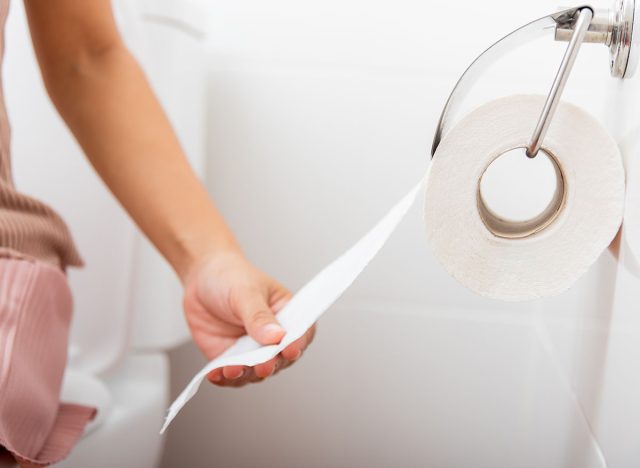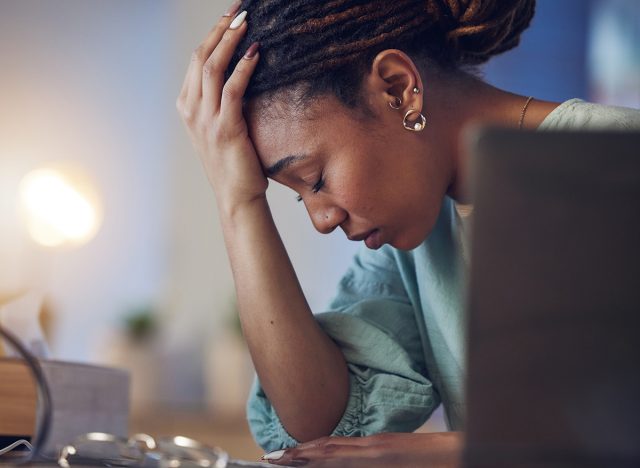15 Red Flags Sabotaging Your Weight Loss

Are you struggling to lose weight? It could be that you are sabotaging your success – but you don't even know it. It could also have to do with gut health red flags. According to Jamie Maitland, Certified Holistic Nutritionist, Fitness Trainer, Founder of The Office Health, and author of The 21 Day Reset Cookbook, there are a bunch of health habits that may be sabotaging your weight loss. Here are 15 to look out for.
Poor Sleep

Poor sleep is majorly tied to weight loss, says Maitland. "It might sound a bit cliche, but sleep is extremely important!" she explains. "Sleep is vital for both physical and mental health. It quite literally helps the body store energy, repair injuries, improve memory, and grow."
Not Drinking Enough Water

Inadequate water intake is another health habit that could be getting in the way of your weight loss. "Water is life," exclaims Maitland. "We are 70% water. Water helps get rid of waste in the body, can help keep you feeling full, and adequate water intake helps break down fat cells."
Not Understanding Your Insulin Resistance

Not knowing your insulin resistance and why it's so important may also be getting in the way of your weight loss. "Insulin is our master fat-storing hormone," says Maitland. "It is produced in the pancreas and plays a key role in regulating energy and macron balance within the body."
Skin Issues

Are you experiencing skin problems? "Most all skin conditions are linked to gut bacteria imbalances," says Maitland.
Chronic Fatigue

If you are experiencing chronic fatigue, there could be an underlying health issue. "This might be an indication of poor nutrient absorption," says Maitland.
RELATED: 12-3-30 Walking Method: 20 Proven Tips to Lose Weight Faster
Chronic Bloating

"Chronic bloating isn't normal. Stop convincing yourself that it is," says Maitland. "Bloating can be caused by gas, digestion issues, stress, and hormones. Take into consideration what you are actually eating so you can pinpoint what might be making you feel bloated."
Food Intolerance

Food intolerances can also help you understand your gut health better. "It's helpful to know what foods might be triggering inflammation to further help you get to the root of the cause," says Maitland.
Frequent Illness

Are you frequently sick? "This can be a sign of a weak immune system due to poor gut health," says Maitland.
Not Being Able to Stick to a Diet

If you are feeling constantly challenged to stick to a diet, there could be a reason. "It may be because of food cravings and lack of motivation in general," says Maitland.
RELATED: 15 Quick Ways to Lose Body Fat Percentage in a Week
Frequent Diarrhea

There might be gastrointestinal red flags as well, including frequent diarrhea. "This can lead to nutrient deficiencies, which unfortunately can put a halt to your weight loss efforts," says Maitland.
Subhead Goes Right Here

Another gastrointestinal red flat? "Constipation, which can suggest a sluggish digestive system," says Maitland.
Sugar Craving

Sugar cravings can also be responsible for an inability to lose weight. "These can lead to unhealthy food choices," she says.
Mood Swings

If your mood is off balance, you are more likely to eat unhealthy food. "Mood swings and irritability can contribute to emotional eating and weight gain," says Maitland.
Poor Living Environment

A poor living environment can have a major effect on your motivation, says Maitland. "An optimal environment should have you feeling comfortable and safe wherever this space is," she explains. "It should make you feel happy."
RELATED: 11 Superfoods to Maintain Muscle Mass As You Age
Chronic Stress

"Chronic stress, as we all know, can lead to an array of problems inside the body," says Maitland. "Unfortunately, chronic stress can make your weight loss journey a bit more challenging as it can affect your body processes such as your metabolism and appetite."
💪🔥Body Booster: Don't forget to hydrate. The CDC's recommended daily water intake is around 125 ounces (3.7 liters) for men and 91-98 ounces (2.7-2.9 liters) for women, with some variation based on age. Water helps get rid of waste in the body and can help keep you feeling full, and adequate water intake helps break down fat cells.




